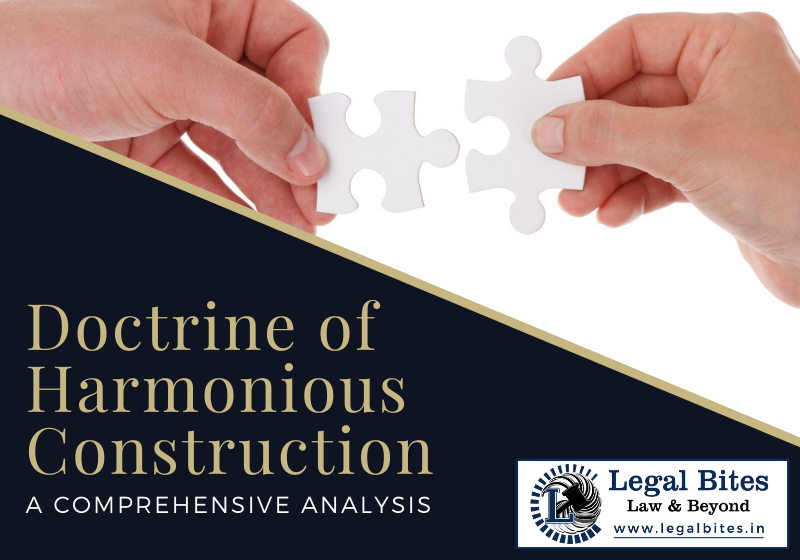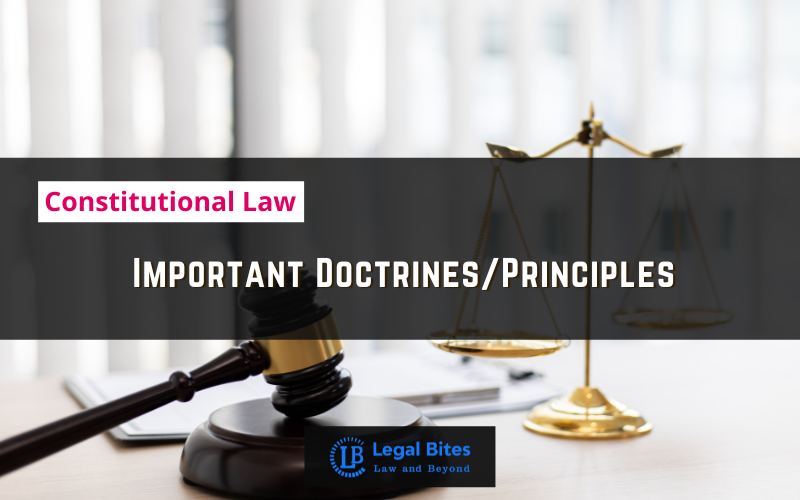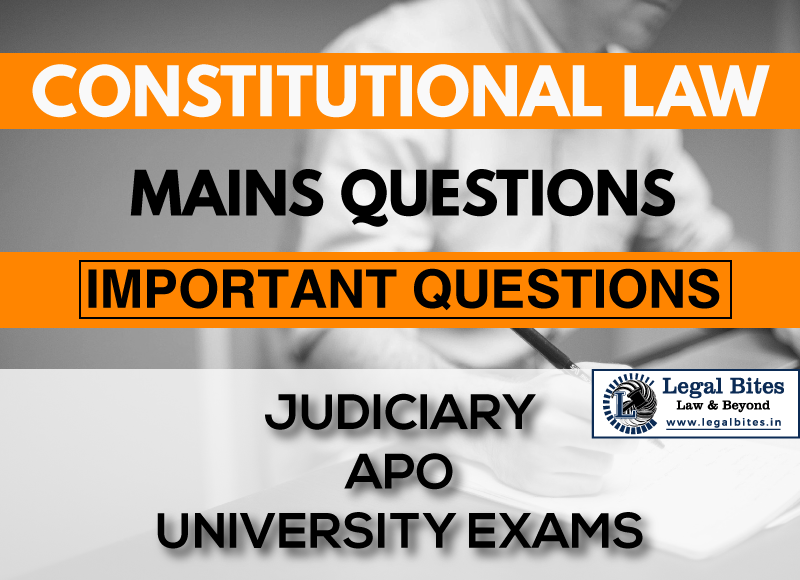Doctrine of Harmonious Construction: A Comprehensive Analysis
The Parliament makes a separate set of statutes, rules and legislation as well as constitutional provisions under their well-defined powers. While the framing of these provisions has to be done very carefully, conflict still occurs sometimes due to overlapping in their enforcement. This is because there are chances of certain gaps being left… Read More »
;
The Doctrine of Harmonious Construction: The Parliament makes a separate set of statutes, rules, legislation, and constitutional provisions under their well-defined powers. While framing these provisions has to be done very carefully, conflict sometimes occurs due to overlapping in their enforcement. This is because there are chances of certain gaps being left while framing of these provisions, which legislators could not have foreseen. To deal with such conflicts, certain doctrines and...
The Doctrine of Harmonious Construction: The Parliament makes a separate set of statutes, rules, legislation, and constitutional provisions under their well-defined powers. While framing these provisions has to be done very carefully, conflict sometimes occurs due to overlapping in their enforcement. This is because there are chances of certain gaps being left while framing of these provisions, which legislators could not have foreseen. To deal with such conflicts, certain doctrines and rules are propounded by courts that are used in the interpretation of statutes. One such rule of interpretation is the Doctrine of Harmonious Construction.
This article provides an overview of the doctrine along with case laws.
I. Meaning of the Doctrine of Harmonious Construction
The Doctrine of Harmonious Construction is considered the thumb rule to the rule of interpreting statutes. The doctrine states:
“Whenever there is a case of conflict between two or more statutes or between two or more parts or provisions of a statute, then the statute has to be interpreted upon harmonious construction. It signifies that in case of inconsistencies, proper harmonization is to be done between the conflicting parts so that one part does not defeat the purpose of another.”
The doctrine is based on a cardinal principle in law that every statute has been formulated with a specific purpose and intention and should be read as a whole. The normal presumption is that what Parliament has given by one hand is not sought to be taken away from another. The essence is to give effect to both the provision. The adopted interpretation of the statute should be consistent with all its provisions to avoid conflict.
If there seems an impossibility to construe or reconcile the parts/provisions harmoniously, then the matter rests with the judiciary to decide and give final judgment. The aim of the courts is to make interpretations in a manner that resolves the repugnancy or inconsistency between the provisions and enables the statute to become consistent as a whole and read accordingly.
II. Origin of the Doctrine
The Doctrine of Harmonious construction originated through interpretations given by courts in a number of cases. The evolution of the doctrine can be traced back to the very first amendment made in the Constitution of India with the landmark judgment of Shankari Prasad v. Union of India [1]. The case dealt with the conflict between parts III (Fundamental Rights) and IV (Directive Principles of State Policy), which form basic features of the Indian Constitution.
The court applied the rule of Harmonious Construction and held that Fundamental rights being rights given against the state, can be taken away in certain situations and can be amended as well by the Parliament to bring them in conformity with constitutional provisions. Preference was given to both and it was decided that FRs and DPSPs are just two different sides of the same coin that requires working together for the public good.
Historically, this doctrine evolved through the rule of conciliation first propounded in the case of C.P. and Berar Act [2]. The court applied this rule of interpretation to avoid overlapping or inconsistency between entry 24 and entry 25 of the State list and read them harmoniously by determining the extent of the concerned subjects.
III. Applicability of the Doctrine
To quote court's view on the application of the doctrine of harmonious construction:
“When there are in an enactment two provisions which cannot be reconciled with each other, they should be so interpreted that; if possible, the effect should be given to both.” [3]
It is a well-settled principle that a statute must be read as a whole and in a manner that one part/provision of the act is harmoniously construed in reference to the other provisions of the same Act so as to provide a consistent enactment of the whole statute. [4]
There are five principles of this Doctrine as laid down by the apex court of India in the case of CIT v. Hindustan Bulk Carrier:
- “While interpreting, the court has a duty to avoid a “head-on clash” at all costs between two sections of the same act
- The interpretation should be done such that the provision of one section doesn’t defeat the purpose of another unless it is impossible to effect a reconciliation between them.
- When it is impossible to reconcile the contradictory provisions, then courts must interpret in a way to give as much as possible effect to both provisions.
- A Construction that reduces one of the provisions to a “useless lumber” or “dead letter” is not harmonious construction.
- Lastly, to harmonize is not to destroy any other statutory provisions.” [5]
The aforesaid principles give basic yet clear explanations of the usage of the rule of Harmonious Construction while interpreting parts of any statute.
Moreover, when two provisions of a statute are in apparent conflict with each other, then both must be interpreted in a way that gives effect to both, and no such construction should be adopted that renders either of the provisions useless or inoperative except in the last resort. The Supreme Court has clearly illustrated the use of this principle in Raj Krushna v. Binod Kanungo [6] case.
Section 33(2) and 123(8) of ROPA, 1951 were in apparent conflict. Where section 33(2) talks about the power of a government servant to nominate or second a person in an election, the other section 123(8) specifies that a government servant cannot assist any candidate in the election except by casting his vote [7]. The court interpreted both sections harmoniously and held that a government servant has both the right to nominate or second a candidate but is forbidden to assist in any other manner and he also has the right to vote.
IV. Relevant Case Laws
To have a fair understanding of the concept of this interpretation rule, it is important that we read upon its actual applicability in relevant case laws.
The first is the landmark judgment in the history of the Indian Constitution, M.S.M Sharma v. Krishna Sinha. The Petitioner in the case was alleged with that he has breached the privileges of the speaker for publishing a speech which was delivered by the member. A show-cause notice was issued to the Petitioner for why action should not be taken against him.
Issue of the case: Whether the privileges under Art. 194(3) prevail over the fundamental right under Art. 19 (1)(a)? [8]
Petitioner’s Contention: The action taken by the Committee and the notice sent stands in violation of his fundamental rights under Art 19 (1)(a) and Art. 21. However, since the respondent relied on Art. 194(3), the rule of interpretation was involved as to which provision shall prevail.
Held: The Supreme Court applied the rule of harmonious construction and held that though Art. 194 (3) is subordinate to Art. 21 but Indian Constitution is the supreme law in the country, and therefore, a person can be expunged from publishing the official records of the Assembly. This is not a complete prohibition on the fundamental right of that person.
Further, in the case of M. Nanavati v. State of Bombay [9], the matter was related to the power conferred to the Governor under Art 161, and the court has to interpret the scope of Art 161 and Art 142 (1) of the constitution. In the present case, Bombay HC passed a sentence against the accused. The petitioner then approached the Governor, who passed a suspension order against the sentence of Bombay HC.
When the matter reached before Hon’ble Supreme Court, the court applied the rule of Harmonious Construction and held that the absolute power of granting suspension to the Governor under Art 161 becomes absolved when the matter becomes sub judice. In such situations, there is a complete scope of interference with the judicial power of the court under Art 142.
Recently in the case of Department of Customs v. Sharad Gandhi [10], the Hon’ble Supreme Court has again applied the principle of Harmonious construction to resolve the inconsistency between the Antiquities and Art Treasures Act, 1972 and Customs Act, 1962. The Bench observed the “inconsistency” found in Article 254 of the Indian Constitution between laws made by Parliament and state legislatures, stating: If the law made by the state is repugnant to the law made by the parliament, then law made by the parliament shall prevail to the extent of repugnance [11]. However, in the present case, the court observed that both the said act have been made by Parliament.
V. Conclusion
It is clear that there is always a possibility of ambiguity or gaps in the laws made by the legislature. To fill those gaps, Harmonious construction as a rule of interpretation of statutes plays a huge role in giving maximum effect to the statutory provisions. Today, considered a chief tool in the hands of our Judiciary, the rule helps two confronting laws work together harmoniously in delivering justice to society at large.
References
[1] Shankari Prasad v. Union of India, AIR (1951) SC 455.
[2] Re C.P. and Bera Act, AIR (1939) FC 1.
[3] Venkataramana Devaru v. State of Mysore, 1958 AIR 255.
[4] Justice GP Singh, Principles of Statutory Interpretation, 9th edn (2004) 131.
[5] CIT v. Hindustan Bulk Carriers (2003) 3 SCC 57.
[6] Raj Krushna Bose v. Binod Kanungo & ors, 1954 AIR 202.
[7] Representation of People Act, 1951 Section 33(2) & 123(8).
[8] M.S.M. Sharma v. Krishna Sinha, AIR (1959) SC 395.
[9] K.M. Nanavati v. State of Bombay, AIR 1961 SC 112.
[10] Department of Customs v. Sharad Gandhi, SLP (Crl.) No. 174 of 2019.
[11] Constitution of India, Art. 254.




